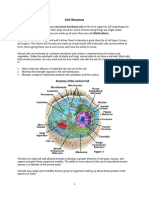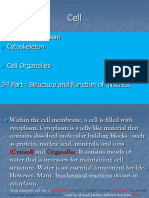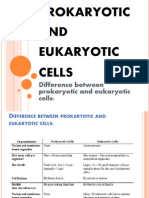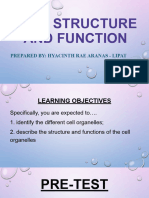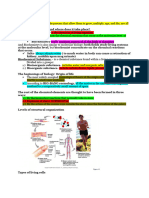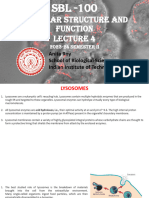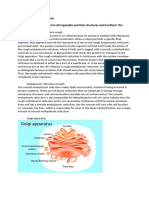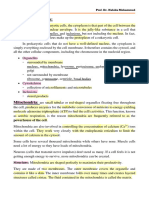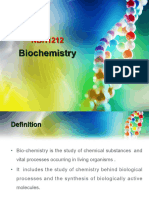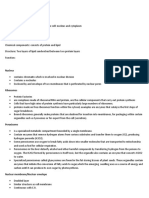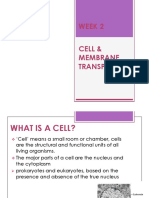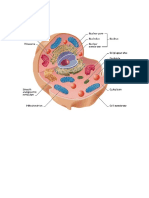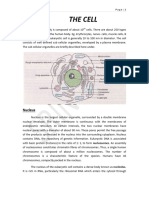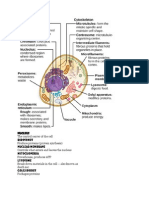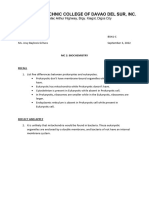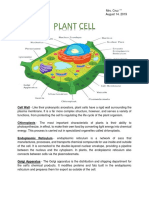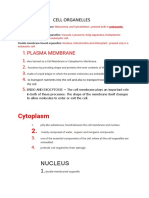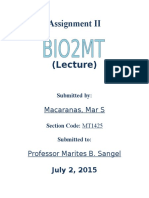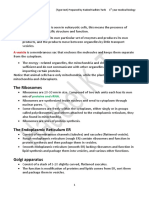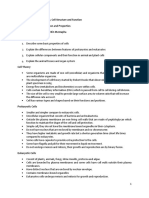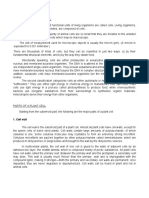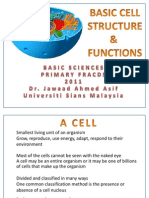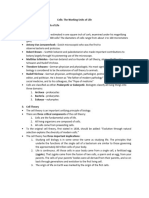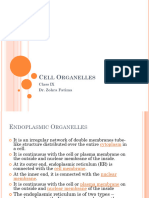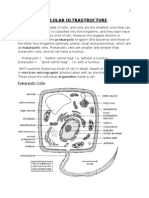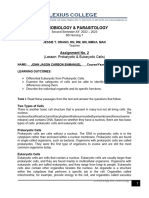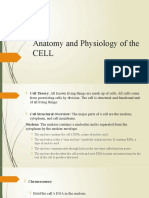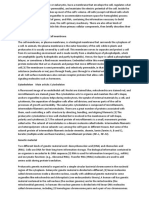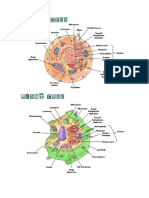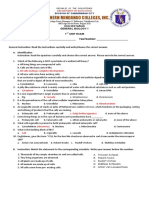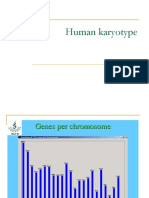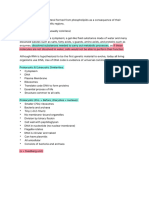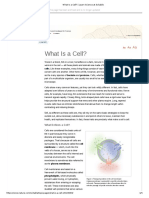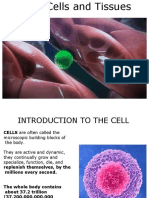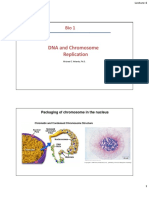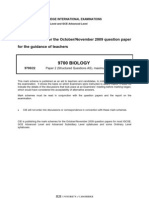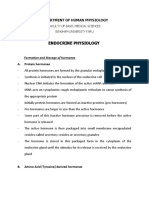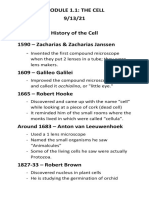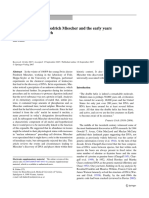100%(1)100% found this document useful (1 vote)
35 viewsCells, Organelles, Microscopy Techniques
Cells, Organelles, Microscopy Techniques
Uploaded by
JeffreyThis document provides an overview of cellular organelles and microscopy techniques. It discusses the membrane-enclosed organelles found in eukaryotic cells, including the nucleus, endoplasmic reticulum, Golgi apparatus, lysosomes, mitochondria, chloroplasts, and cytoskeleton. Each organelle has a distinct structure and specialized function, such as protein synthesis, modification and transport, waste disposal, energy production, and maintaining cell structure. The document also notes that organelles are held in position by the cytoskeleton and their movements are driven by motor proteins.
Copyright:
© All Rights Reserved
Available Formats
Download as PDF, TXT or read online from Scribd
Cells, Organelles, Microscopy Techniques
Cells, Organelles, Microscopy Techniques
Uploaded by
Jeffrey100%(1)100% found this document useful (1 vote)
35 views34 pagesThis document provides an overview of cellular organelles and microscopy techniques. It discusses the membrane-enclosed organelles found in eukaryotic cells, including the nucleus, endoplasmic reticulum, Golgi apparatus, lysosomes, mitochondria, chloroplasts, and cytoskeleton. Each organelle has a distinct structure and specialized function, such as protein synthesis, modification and transport, waste disposal, energy production, and maintaining cell structure. The document also notes that organelles are held in position by the cytoskeleton and their movements are driven by motor proteins.
Original Description:
check number 4
Copyright
© © All Rights Reserved
Available Formats
PDF, TXT or read online from Scribd
Share this document
Did you find this document useful?
Is this content inappropriate?
This document provides an overview of cellular organelles and microscopy techniques. It discusses the membrane-enclosed organelles found in eukaryotic cells, including the nucleus, endoplasmic reticulum, Golgi apparatus, lysosomes, mitochondria, chloroplasts, and cytoskeleton. Each organelle has a distinct structure and specialized function, such as protein synthesis, modification and transport, waste disposal, energy production, and maintaining cell structure. The document also notes that organelles are held in position by the cytoskeleton and their movements are driven by motor proteins.
Copyright:
© All Rights Reserved
Available Formats
Download as PDF, TXT or read online from Scribd
Download as pdf or txt
100%(1)100% found this document useful (1 vote)
35 views34 pagesCells, Organelles, Microscopy Techniques
Cells, Organelles, Microscopy Techniques
Uploaded by
JeffreyThis document provides an overview of cellular organelles and microscopy techniques. It discusses the membrane-enclosed organelles found in eukaryotic cells, including the nucleus, endoplasmic reticulum, Golgi apparatus, lysosomes, mitochondria, chloroplasts, and cytoskeleton. Each organelle has a distinct structure and specialized function, such as protein synthesis, modification and transport, waste disposal, energy production, and maintaining cell structure. The document also notes that organelles are held in position by the cytoskeleton and their movements are driven by motor proteins.
Copyright:
© All Rights Reserved
Available Formats
Download as PDF, TXT or read online from Scribd
Download as pdf or txt
You are on page 1of 34
BME 1532-CELL BIOLOGY
Cellular Organelles and
Microscopy Techniques
by Assist. Prof. Görke Gürel Peközer
Yıldız Technical University
Biomedical Engineering Department
Spring 2020
Last Week on BME 1532
Cells as the Basic Units of Life
Universal Features of All Cells
Biomacromolecules
Code of Life
Gene Expression
Common Structural Elements of All Cells
Prokaryotes and Eukaryotes
Ribosomes
Endosymbiotic Theory
Membrane Enclosed Organelles in Eukaryotic Cells
Bacteria and archea consists of a single compartment enclosed by the
plasma membrane, eukaryotic cells are elaborately subdivided by
internal membranes.
These structures that are enclosed by membranes are all distinct,
membrane-enclosed organelles, each of which contains a unique set of
large and small molecules and carries out a specialized function.
These membranes also participate directly in the cell's metabolism,
because many enzymes are found in the membranes.
Furthermore, the cell's compartments provide different local
environments that facilitate specific metabolic functions, so
incompatible processes can go on simultaneously inside the same cell.
If the cell did not have distinct membrane enclosed spaces for
metabolic functions, both synthesis and degradation of
biomacromolecules would occur in the same compartment
(cytoplasm) and this would be very chaotic and harmful to the cell.
Membranes of various kinds are fundamental to the
organization of the cell.
In general, biological membranes consist of a double
layer of phospholipids and other lipids. In this lipid
bilayer, proteins are embedded or attached to its
surfaces.
However, each type of membrane has a unique
composition of lipids and proteins suited to that
membrane's specific functions.
Nucleus
The nucleus is generally the most prominent organelle in eukaryotic cells. It contains
molecules of DNA.
It has evolved to keep the DNA segregated from the physical and chemical chaos of the
cytoplasm to allow delicate and complex control of the way the cell reads out its genetic
information.
It is surrounded by a double membrane, known as the nuclear envelope, and
communicates with the cytosol via nuclear pores that perforate the envelope.
Nuclear pores are protein complexes that regulate the entry and exit of certain large
macromolecules and particles.
Nucleoli is the dense region of nucleus in which ribosomal RNA (rRNA) are synthesized
and ribosomes are assembled.
The nucleus directs protein
synthesis by synthesizing
messenger RNA (mRNA)
according to instructions
provided by the DNA.
The mRNA is then Nucleus
transported to the cytoplasm
Cytoplasm
via the nuclear pores.
Once an mRNA molecule
reaches the cytoplasm, Ribosome
mRNA
Protein
ribosornes translate the
mRNA's genetic message into
the primary structure of a
specific polypeptide.
Endoplasmic Reticulum
Outer nuclear membrane is continuous
with the membrane of the endoplasmic
reticulum (ER), a system of
interconnected sacs and tubes of
membrane that often extends
throughout most of the cell.
The ER is the major site of synthesis of
new membranes in the cell.
Large areas of the ER have ribosomes
attached to the cytosolic surface and
are designated rough endoplasmic
reticulum (rough ER).
The ribosomes are actively
synthesizing proteins that are delivered
into the ER membrane or into the ER
interior, a space called the lumen.
The smooth endoplasmic reticulum (smooth ER) lacks
ribosomes. It is the site of steroid hormone synthesis
in some endocrine cells of the adrenal gland and the
site where a variety of organic molecules, including
alcohol, are detoxified in liver cells.
In many eukaryotic cells, the smooth ER also
sequesters Ca2+ from the cytosol; the release and
reuptake of Ca2+ from the ER are involved in the rapid
response to many extracellular signals.
Golgi Apparatus
The Golgi apparatus, which is usually situated near the nucleus,
receives proteins and lipids from the ER, modifies them, and then
dispatches them to other destinations in the cell.
Transport vesicles move material from the ER to the Golgi
apparatus. Vesicles fuse to the membrane of the golgi apparatus
where they are modified.
Golgi products that will be secreted depart the Golgi inside
transport vesicles that eventually fuse with the plasma
membrane.
Lysosomes
A lysosome is a membranous sac of hydrolytic enzymes that a cell uses to digest
all kinds of macromolecules.
Inside lysosomes is acidic since lysosomal enzymes work best in the acidic
environment.
If a lysosome breaks open or leaks its contents. The released enzymes are not
very active, because the cytosol has a neutral pH.
However, excessive leakage from a large number of lysosomes can destroy a cell
by autodigestion.
Lysosomes carry out intracellular digestion in a variety of circumstances:
When the molecules are taken into the cell by phagocytosis, the vacuole formed in this
way then fuses with a lysosome, whose enzymes digest the molecules. Digestion
products, including simple sugars, amino acids, and other monomers, pass into the
cytosol and become nutrients for the cell.
Lysosomes also use their hydrolytic enzymes to recycle the cell's own organic material.
A damaged organelle or small amount of cytosol becomes surrounded by a membrane,
and a lysosome fuses with this vesicle. The lysosomal enzymes dismantle the enclosed
material and the organic monomers are returned to the cytosol for reuse.
Mitochondria and (in plant cells) chloroplasts are each
surrounded by a double membrane and are the sites
of oxidative phosphorylation and photosynthesis,
respectively; both contain internal membranes that
are highly specialized for the production of ATP.
Mitochondria
Mitochondria have double membrane.
Mitochondria are generators of chemical energy for
the cell.
They harness the energy from the oxidation of food
molecules, such as sugars, to produce adenosine
triphosphate, or ATP—the basic chemical fuel that
powers most of the cell’s activities.
Because the mitochondrion consumes oxygen and
releases carbon dioxide in the course of this activity,
the entire process is called cellular respiration—
essentially, breathing on a cellular level.
Without mitochondria, animals, fungi, and plants
would be unable to use oxygen to extract the energy
they need from the food molecules that nourish
them.
Mitochondria contain their own DNA and
reproduce by dividing in two.
Chloroplasts
Chloroplasts are large, green organelles that are found
only in the cells of plants and algae, not in the cells of
animals or fungi.
These organelles have an even more complex structure
than mitochondria: in addition to their two
surrounding membranes, they possess internal stacks
of membranes containing the green pigment
chlorophyll.
Chloroplasts carry out photosynthesis—trapping the
energy of sunlight in their chlorophyll molecules and
using this energy to drive the manufacture of energy-
rich sugar molecules.
In the process, they release oxygen as a molecular by-
product.
Plant cells can then extract this stored chemical energy
when they need it, by oxidizing these sugars in their
mitochondria, just as animal cells do.
• Chloroplasts thus enable plants to get their energy directly from sunlight. And they allow
plants to produce the food molecules—and the oxygen—that mitochondria use to generate
chemical energy in the form of ATP.
• Like mitochondria, chloroplasts contain their own DNA, reproduce by dividing in two.
Membrane-enclosed morganelles are distributed
throughout the eukaryotic cell cytoplasm.
Cytosol is the part of the cytoplasm that is not
contained within intracellular membranes.
Cytoskeleton
Many of the membrane-enclosed organelles, including
the ER, Golgi apparatus, mitochondria, and
chloroplasts, are held in their relative locations in the
cell by attachment to the cytoskeleton, especially to
microtubules.
Cytoskeletal filaments provide tracks for moving the
organelles around and for directing the traffic of
vesicles between one organelle and another.
These movements are driven by motor proteins that
use the energy of ATP hydrolysis to propel the
organelles and vesicles along the filaments.
The Cytoplasm Is Organized by the
Cytoskeleton and Is Highly Dynamic
There are several types of protein filaments
crisscrossing the eukaryotic cell, forming an
interlocking three-dimensional meshwork,
the cytoskeleton.
It helps cells maintain their shape and
internal organization, and it also provides
mechanical support that enables cells to
carry out essential functions like transport,
division and movement.
There are three general types of cytoplasmic
filaments—actin filaments, microtubules,
and intermediate filaments —differing in
width (from about 6 to 22 nm), composition,
and specific function.
Cytoskeleton
Each type of cytoskeletal component is
composed of simple protein subunits that
polymerize to form filaments of uniform
thickness.
These filaments are not permanent
structures; they undergo constant
disassembly into their protein subunits and
reassembly into filaments.
Their locations in cells are not rigidly fixed
but may change dramatically with mitosis,
cytokinesis, amoeboid motion, or changes in
cell shape.
The assembly, disassembly, and location of all
types of filaments are regulated by other
proteins, which serve to link or bundle the
filaments or to move cytoplasmic organelles
along the filaments.
Microtubules help distribute
the chromosomes in a dividing cell.
Microtubules Intermediate Filaments Actin Filaments
- Shape - Shape - Shape
- Organization - Organization - Organization
- Division - Movement
- Transport - Transport
Bacteria (Prokaryote)
Animal Cell (Eukaryote) Plant Cell (Eukaryote)
Microscopical Techniques
The development of the light microscope depended on
advances in the production of glass lenses. By the
seventeenth century, lenses were powerful enough to
make out details invisible to the naked eye.
Using an instrument equipped with such a lens, Robert
Hooke examined a piece of cork and in 1665 reported to
the Royal Society of London that the cork was
composed of a mass of minute chambers.
He called these chambers “cells,” based on their
resemblance to the simple rooms occupied by monks in
a monastery.
The name stuck, even though the structures Hooke
described were actually the cell walls that remained
after the living plant cells inside them had died.
Later, Hooke and his Dutch contemporary Antoni van
Leeuwenhoek were able to observe living cells, seeing
for the first time a world teeming with motile
microscopic organisms.
Microscope
Eyepiece (ocular) is the lens the viewer looks
through to see the specimen. The eyepiece
usually contains a 10X lens.
Objective Lenses are the primary optical lenses
on a microscope. They range from 4x-100x and
typically, include, three, four or five lenses on
most microscopes.
Stage is where the specimen to be viewed is
placed.
Course Adjustment Knob controls the height
of the stage and rings the specimen into general
focus.
Fine Adjustment Knob fine tunes the focus and
increases the detail of the specimen.
Diaphram controls the amount of light reaching
the specimen.
Illuminator is the light source for a microscope,
typically located in the base of the microscope.
An inverted microscope is a microscope with its
light source on top and the objective lenses are below
the specimen.
It is generally used for cell culture studies.
Magnification refers to the amount or degree of
visual enlargement of an observed object.
Total Magnification = Ocular lens x Objective lens
Resolution is used to describe the ability of a
microscope to distinguish detail.
Light Microscope
If you cut a very thin slice from a suitable plant
or animal tissue and view it using a light
microscope, you will see that the tissue is
divided into thousands of small cells.
To see the internal structure of a cell is difficult,
not only because the parts are small, but also
because they are transparent and mostly
colorless.
One way around the problem is to stain cells
with dyes that color particular components
differently.
Alternatively, one can exploit the fact that cell
components differ slightly from one another in
refractive index, just as glass differs in refractive
index from water, causing light rays to be
deflected as they pass from the one medium
into the other.
The small differences in refractive index can be
made visible by specialized optical techniques
such as phase contrast microscopy.
Types of Light Microscope
Brightfield Darkfield Phase-Contrast
Microscopy Microscopy Microscopy
The object to be inspected is It has an opaque disk that blocks It enhances the phase difference
normally placed on a clear glass the light which is not passing between the specimen and its
slide, and light is transmitted through the specimen so that only surroundings. Specimens which
though the object. This makes light that is scattered by objects have a refractive index similar to
the object appear against a bright on the slide can reach the eye. their surroundings can be invisible
background. Thus, it shows the specimens in Brightfield, but are well defined
bright on a dark background. in Phase Contrast.
Fluorescence Microscope
Fluorescence Microscopy
also uses light as the
illumination source.
However, it uses filters to
filter the wavelength that
will excite the specimen and
then filter the wavelength
that is emitted from the
specimen.
Fluorescent microscope
can only visualize by
tagging the molecules
with fluorescent dyes or
antibodies. These
fluorescent substances
absorb light and emit
light at a specific
wavelength.
Confocal Microscope
Confocal Microscopy uses lasers of specific wavelength as
the illumination source.
Only a single plane of focus is illuminated; out-af-focus
fluorescence above and below the plane is subtracted by a
computer which results in a sharp image.
Sharper reflecting more details and could be observed in
3D.
Electron Microscope
Although cells were discovered by Robert Hooke in 1665, the
geography of the cell was largely uncharted until the 1950s.
Most subcellular structures, or organelles, are too small to be
resolved by the light microscope.
Instead of using light, the electron microscope (EM) focuses a
beam of electrons through the specimen or onto its surface.
Resolution is inversely related to the wavelength of the radiation
a microscope uses for imaging, and electron beams have
wavelengths much shorter than the wavelengths of visible light.
Thus, an electron microscope can resolve objects that are very
small, down to a few nanometers.
Transmission Electron
Microscope
The type of electron microscope
used to look at thin sections of
tissue is known as a transmission
electron microscope. This is, in
principle, similar to a light
microscope, except that it
transmits a beam of electrons
rather than a beam of light through
the sample.
TEM used mainly mainly to study
the internal ultrastructure of cells
such as organelles, cytoskeleton,
and DNA.
Scanning Electron
Microscope
Another type of electron
microscope—the scanning electron
microscope—scatters electrons off
the surface of the sample and so is
used to look at the surface detail of
cells and other structures.
Thus, SEM is especially useful for
detailed study of the surface of a
specimen.
Even the most powerful electron microscopes, however, cannot visualize the individual atoms that
make up biological molecules.
To study the cell’s key components in atomic detail, biologists have developed even more
sophisticated tools such as atomic force microscopy, nuclear magnetic resonance, X-ray
crystallography etc.
Next Week on BME 1532
DNA
Higher Level Structures of DNA
DNA Replication
DNA repair
You might also like
- Human Heredity Principles and Issues 11th Edition Cummings Test Bank 1Document36 pagesHuman Heredity Principles and Issues 11th Edition Cummings Test Bank 1nicholasmooney16101989rzk100% (45)
- Assignment 1 Biol 1700 Winter 2021 FinalDocument13 pagesAssignment 1 Biol 1700 Winter 2021 Finalapi-546520104No ratings yet
- UNIT 2 Notes PDFDocument88 pagesUNIT 2 Notes PDFAjNo ratings yet
- Ans 201 Anatomy and Physiology of Farm AnimalsDocument33 pagesAns 201 Anatomy and Physiology of Farm AnimalsAdewaleNo ratings yet
- CytologyDocument15 pagesCytologyaviatorlegacy01No ratings yet
- Week 7. Reading Materials - Cell Structure and Function 2021Document4 pagesWeek 7. Reading Materials - Cell Structure and Function 2021yui kirigayayuukiNo ratings yet
- 06_A-Tour-of-the-Cell_LODocument7 pages06_A-Tour-of-the-Cell_LOAngelineNo ratings yet
- Cell Structures: The BasicsDocument4 pagesCell Structures: The BasicsParama CinthyaNo ratings yet
- CellDocument8 pagesCellWhyL NificentNo ratings yet
- Lecture 2 CytoplasmmDocument46 pagesLecture 2 Cytoplasmmdiyarberwari15No ratings yet
- 1.3. Components of The Cell IISubcellular Organelles 070141Document31 pages1.3. Components of The Cell IISubcellular Organelles 070141Angel CaroNo ratings yet
- Prokaryotic and Eukaryotic CellsDocument18 pagesProkaryotic and Eukaryotic Cellssalahuddin_md5935100% (1)
- Cell Structure and FunctionDocument38 pagesCell Structure and FunctionHyacinth RaeNo ratings yet
- BIOCHEMISTRYDocument6 pagesBIOCHEMISTRYAngel ManlaviNo ratings yet
- Lec-8,9 CellsDocument30 pagesLec-8,9 CellsAbdullah-Al-mehedi HiraNo ratings yet
- Morphological Function of The Cell Presentation PHDocument52 pagesMorphological Function of The Cell Presentation PHDoc HamsNo ratings yet
- Cellular Structure and Function Lectrue 4Document24 pagesCellular Structure and Function Lectrue 4madhav biyaniNo ratings yet
- Tutorial case 5 learning goalsDocument8 pagesTutorial case 5 learning goalsseppaendekerkNo ratings yet
- Chapte 3Document22 pagesChapte 3axmedjiinjeaxmedNo ratings yet
- LESSONS in BIOCHEMDocument39 pagesLESSONS in BIOCHEMMikhael Jay IglesiasNo ratings yet
- بايو م 2Document7 pagesبايو م 2alidoctor678No ratings yet
- Intro, Cell, TissueDocument29 pagesIntro, Cell, Tissueanisa930804No ratings yet
- Phospholipids (Fats With Phosphorous Attached), Which at Body Temperature AreDocument7 pagesPhospholipids (Fats With Phosphorous Attached), Which at Body Temperature AreCmae VidadNo ratings yet
- Cell Structures and Its Functions Cell WallDocument5 pagesCell Structures and Its Functions Cell WallNorjanah H. M. AmbolaNo ratings yet
- Forest Botany For Forestry StudentsDocument39 pagesForest Botany For Forestry StudentsMadan ThapaNo ratings yet
- Structure and Function of The CellDocument43 pagesStructure and Function of The CellElvie Gutierrez100% (1)
- HDTD-B-4 - Cell OrganellesDocument43 pagesHDTD-B-4 - Cell OrganellesMariam Qais100% (1)
- General Biology ReviewerDocument6 pagesGeneral Biology ReviewerBaby AleiraNo ratings yet
- Human Cell, Feb. 2012.Document3 pagesHuman Cell, Feb. 2012.Nina UrakovićNo ratings yet
- Animal CellDocument6 pagesAnimal Cellmiss_cuteeNo ratings yet
- Anatomy and Physiology: The CellDocument8 pagesAnatomy and Physiology: The Celllourd nabNo ratings yet
- Biohem NotesDocument118 pagesBiohem Notesdalweravikumar69No ratings yet
- NucleusDocument10 pagesNucleusjhariesargente05No ratings yet
- Gen BioCell TheoryDocument18 pagesGen BioCell TheoryBernadeth CayaosNo ratings yet
- BiochemistryDocument4 pagesBiochemistryAaliyah Ashley CerboNo ratings yet
- Chapter - 5 Cell - The Fundamental Unit of Life - Class Ix Cbse - ScienceDocument34 pagesChapter - 5 Cell - The Fundamental Unit of Life - Class Ix Cbse - ScienceMadhav DayareNo ratings yet
- Biochem Hw1 CellDocument5 pagesBiochem Hw1 Celljazzmin ivy evaNo ratings yet
- Cytoplasm 2.: Cell OrganellesDocument6 pagesCytoplasm 2.: Cell OrganellesSai Deekshita VijayakumarNo ratings yet
- Assignment II: Macaranas, Mar SDocument7 pagesAssignment II: Macaranas, Mar SMar MacaranasNo ratings yet
- The OrganellesDocument4 pagesThe Organellesabdullah aliNo ratings yet
- Cell Biology Lecture 1Document17 pagesCell Biology Lecture 1NIMRAHNo ratings yet
- Life Processes and Cells: Chapter 1:-Longman GCSE BiologyDocument16 pagesLife Processes and Cells: Chapter 1:-Longman GCSE BiologynkllaeNo ratings yet
- Cell Structure Function and PropertiesDocument10 pagesCell Structure Function and PropertiesWanda JohnNo ratings yet
- The Plant Cell Pharma With Bot&tax Week 4-6Document10 pagesThe Plant Cell Pharma With Bot&tax Week 4-6Katrina CarolasanNo ratings yet
- Cells InfoDocument4 pagesCells InfoLyza PacibeNo ratings yet
- Cell BiologyDocument4 pagesCell BiologyasadzamanchathaNo ratings yet
- Basic Cell Structure & FunctionDocument27 pagesBasic Cell Structure & FunctionJawaad AsifNo ratings yet
- Biology REVIEW FOR CMDocument12 pagesBiology REVIEW FOR CMyangyang804574No ratings yet
- Module IDocument18 pagesModule IAdvith A JNo ratings yet
- BiochemistryDocument531 pagesBiochemistrySiss Thwae100% (1)
- Cell Basics by MuneebDocument45 pagesCell Basics by MuneebMuneeb Ur RehmanNo ratings yet
- Cell OrganellesDocument38 pagesCell Organellesjeetjyoti787No ratings yet
- Cellular Ultrastructure: Eukaryotic CellsDocument9 pagesCellular Ultrastructure: Eukaryotic CellsPiriyatharshini RamanathNo ratings yet
- Kingdom: Animal CellDocument8 pagesKingdom: Animal CellShaila IvoryNo ratings yet
- NUCLEUS NUCLEAR STRUCTURES and ORGANELLESDocument39 pagesNUCLEUS NUCLEAR STRUCTURES and ORGANELLESolawandeilo123No ratings yet
- L.3 - The CellDocument3 pagesL.3 - The CellJari JariNo ratings yet
- ENMANUEL MC 3 BSN1 Assignment No. 2 Prokaryotic Eukaryotic First TrinalDocument6 pagesENMANUEL MC 3 BSN1 Assignment No. 2 Prokaryotic Eukaryotic First TrinalJason Carbon EnmanuelNo ratings yet
- Biology ProjectDocument6 pagesBiology ProjectBemnet TayeNo ratings yet
- Anatomy and Physiology of The CELLDocument14 pagesAnatomy and Physiology of The CELLlorelie asisNo ratings yet
- Membrane Main Article: Cell MembraneDocument3 pagesMembrane Main Article: Cell MembraneAriella ZoeyNo ratings yet
- Lec 2-Cell BiologyDocument48 pagesLec 2-Cell BiologyHowra KiyasdeenNo ratings yet
- CellDocument4 pagesCellPrincess MillanNo ratings yet
- The Basics of Cell Life with Max Axiom, Super Scientist: 4D An Augmented Reading Science ExperienceFrom EverandThe Basics of Cell Life with Max Axiom, Super Scientist: 4D An Augmented Reading Science ExperienceNo ratings yet
- Activity No.1 Cell and Molecular BiologyDocument4 pagesActivity No.1 Cell and Molecular Biologyjocelynmillano115100% (1)
- 1ST UNIT EXAM Gen Bio 1key AnswerDocument4 pages1ST UNIT EXAM Gen Bio 1key AnswerMea-Ann OscianasNo ratings yet
- KARYOTYPEDocument23 pagesKARYOTYPELucia AndreeaNo ratings yet
- Cellular Biology: Cicel M Reyna M.DDocument35 pagesCellular Biology: Cicel M Reyna M.DStephKirstin Velasco MalapitNo ratings yet
- 2-2 - Components and Functions (IB Biology SL)Document7 pages2-2 - Components and Functions (IB Biology SL)rastete195No ratings yet
- Cell Division Mitosis For Guided Notes Powerpoint 11 3 17Document20 pagesCell Division Mitosis For Guided Notes Powerpoint 11 3 17api-262586446100% (1)
- Biology 10-12 Revised Edition 2Document138 pagesBiology 10-12 Revised Edition 2Mwami JayNo ratings yet
- Background of GeneticsDocument23 pagesBackground of GeneticsvubioNo ratings yet
- What Is A Cell - Learn Science at ScitableDocument5 pagesWhat Is A Cell - Learn Science at ScitableChristopher BrownNo ratings yet
- Lewin's CELLS. ISBN 1284029395, 978-1284029390Document23 pagesLewin's CELLS. ISBN 1284029395, 978-1284029390alizamonrealmmh100% (13)
- proeukaryoticADMModule - Grade12 - Quarter1STEM - BIO12-Ia-c-3 DAN SIMON P. AQUINODocument26 pagesproeukaryoticADMModule - Grade12 - Quarter1STEM - BIO12-Ia-c-3 DAN SIMON P. AQUINOLyka Mae BenitoNo ratings yet
- Cells and Tissues - RevDocument51 pagesCells and Tissues - RevChai MilorenNo ratings yet
- Lecture III-2 DNA and Chromosome StructuresDocument21 pagesLecture III-2 DNA and Chromosome StructuresJÜnn BatacNo ratings yet
- 9700 BIOLOGY: MARK SCHEME For The October/November 2009 Question Paper For The Guidance of TeachersDocument7 pages9700 BIOLOGY: MARK SCHEME For The October/November 2009 Question Paper For The Guidance of TeachersKaren OngNo ratings yet
- The Visual Dictionary of Animal Kingdom PDFDocument174 pagesThe Visual Dictionary of Animal Kingdom PDFGregorio Parra100% (1)
- Cell Organelles LectureDocument54 pagesCell Organelles LectureAlthea Aubrey AgbayaniNo ratings yet
- 001 Advanced BiologyDocument273 pages001 Advanced BiologyGcinumuzi NdunaNo ratings yet
- 1 RhizopodaDocument24 pages1 RhizopodaMohammad Fadel SatriansyahNo ratings yet
- Endocrine Physiology Lecture 2Document9 pagesEndocrine Physiology Lecture 2Tofunmi Kunle-KunbiNo ratings yet
- BiotDocument13 pagesBiotJOSCEL SYJONGTIANNo ratings yet
- Suggested Answers To Exercise, Reading To Learn and Cross-Topic ExerciseDocument23 pagesSuggested Answers To Exercise, Reading To Learn and Cross-Topic ExerciseNigerian NegusNo ratings yet
- Descubrimiento Del DNADocument17 pagesDescubrimiento Del DNAJorgeVictorMauriceLiraNo ratings yet
- C Bot-201Document3 pagesC Bot-201Abdullah Mukhtar MirzaNo ratings yet
- Sci 2Document3 pagesSci 2RonalynAlonsabeBernadasNo ratings yet
- Ap Biology Exam Essay (Free Response) Questions: Unit 1 Biochemistry, Water, EnzymesDocument37 pagesAp Biology Exam Essay (Free Response) Questions: Unit 1 Biochemistry, Water, EnzymesBeatrice MallariNo ratings yet
- General Biology 1 Module 2 Q1Document17 pagesGeneral Biology 1 Module 2 Q1Pril Gueta83% (12)
- Cell (Biology) - WikipediaDocument29 pagesCell (Biology) - WikipediaMokariya SanjayNo ratings yet




